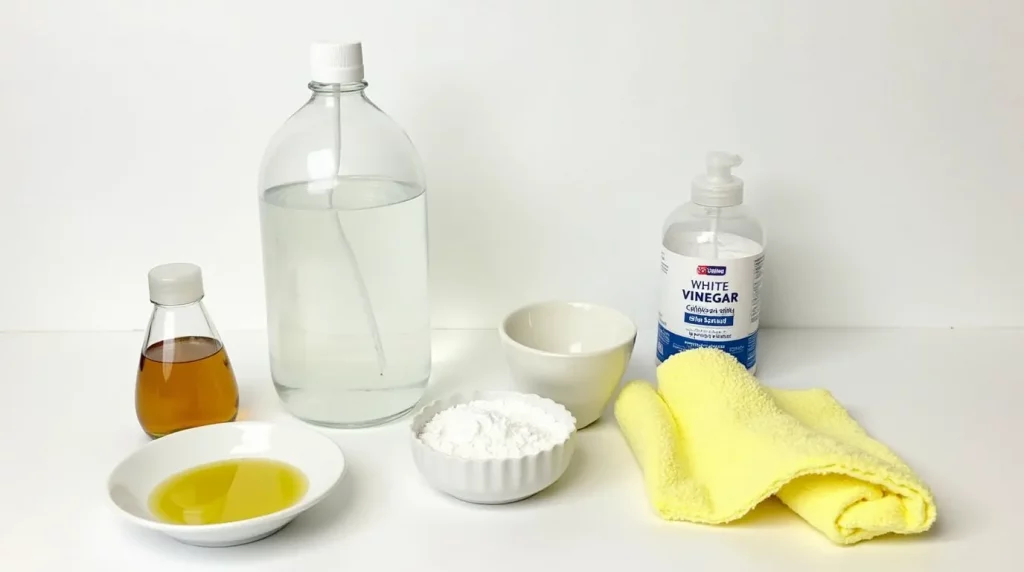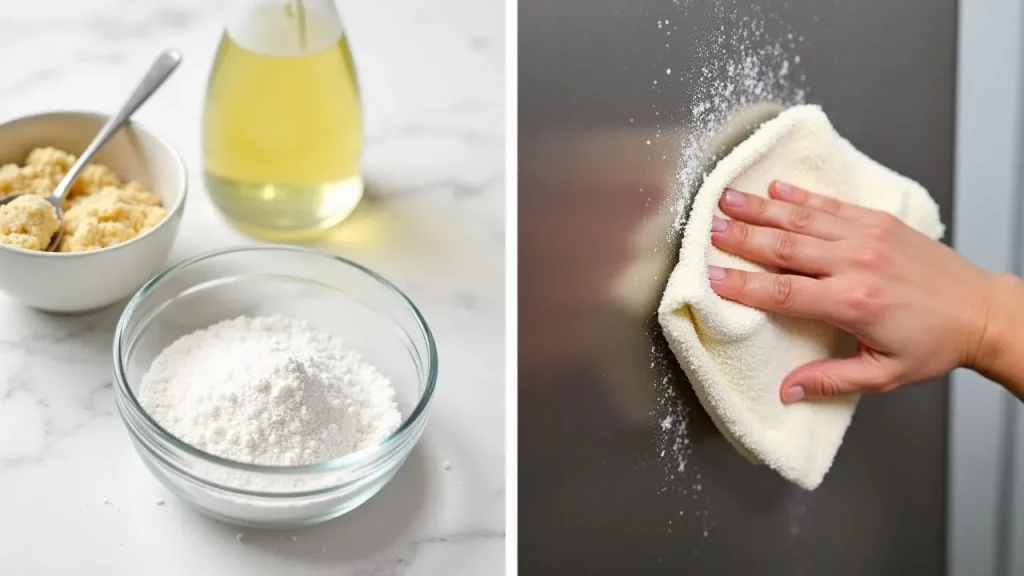Table of Contents
Stainless steel is one of the favorite materials of modern homes. It is known for its elegant appearance and durability. It’s also resistant to rust and stains, although stainless steel can lose its shine when covered with fingerprints, water spots, and stains.
The good news? You can clean it with products and solutions in supermarkets or do it yourself. With a DIY stainless steel cleaner, you can quickly and inexpensively keep your surfaces looking new.
This guide will teach you how to make your cleaner and explain how to clean stainless steel perfectly.
Why Make Your Own Stainless Steel Cleaner?
Making your stainless steel cleaner offers several advantages that we can list right after:
- Sufficient cleaning power: A simple homemade stainless steel cleaner is just as effective at removing fingerprints, grease, and water spots as commercial products, if not more.
- Savings: You can save money by making cleaners with essential ingredients like vinegar, olive oil, and water instead of buying expensive stainless steel cleaners from the supermarket.
- Health: Commercial cleaners contain chemicals that can harm your health, while homemade stainless steel cleaners are made from natural, non-chemical materials.
- Environmental benefits: Cleaners bought from markets are often packaged in plastic bottles, contributing to environmental pollution. Therefore, a homemade cleaner is a more environmentally friendly choice.
Materials Needed for DIY Stainless Steel Cleaner

Before you get started, make sure you have all the materials you need to create your DIY cleaner and effectively polish your stainless steel surfaces. Here’s what you’ll need:
- White Vinegar: Known for its powerful cleaning and disinfecting properties, white vinegar breaks down grease, grime, and water stains effortlessly.
- Olive Oil or Mineral Oil: After cleaning, these oils add a lustrous shine and create a protective barrier on stainless steel.
- Microfiber Cloths: Essential for avoiding scratches and achieving a streak-free finish.
- Spray Bottle: Perfect for applying your vinegar solution evenly across the surface.
- Dish Soap (optional): If you’re dealing with harsh, greasy residue, a drop or two of dish soap can boost the cleaning power.
- 1 tablespoon Cornstarch (optional): Adds a gentle abrasive for tackling grease and tougher spots.
How to Make a DIY Stainless Steel Cleaner

You don’t need complicated ingredients or specialized tools to create a practical stainless steel cleaner. Just follow these simple steps:
Ingredients:
- 1 part white vinegar
- 1 part water
- A few drops of olive oil or mineral oil
- (Optional) 1 tablespoon cornstarch – adds gentle abrasiveness for tackling grease and more challenging spots.
Instructions:
- Mix the Cleaning Solution: Combine equal parts white vinegar and water in a spray bottle. If you’re dealing with greasy or heavily soiled areas, add 1 tablespoon of cornstarch to the mixture. Shake well to ensure everything is thoroughly combined.
- Apply the Cleaner: Spray the solution directly onto your stainless steel surface. The cornstarch will help absorb grease and add a mild abrasive for more challenging spots. For regular cleaning, stick to the vinegar and water mixture without cornstarch.
- Wipe the Surface Clean: Use a microfiber cloth to wipe the Surface in the direction of the grain, ensuring a streak-free shine. Cornstarch helps scrub away any stubborn residue.
- Polish with Oil: After cleaning, apply a small amount of olive oil or mineral oil to a fresh microfiber cloth. Buff the Surface in circular motions to add a protective shine, following the grain for best results.
Why Use Cornstarch in a DIY Stainless Steel Cleaner?

Cornstarch adds a gentle abrasive quality to your DIY cleaner, making it easier to tackle greasy smudges and tough spots. It’s particularly helpful for surfaces that see a lot of use, like kitchen appliances. When mixed with vinegar and water, cornstarch absorbs oils and leaves your stainless steel looking streak-free. While it’s optional, it can provide an extra boost when cleaning more stubborn stains or grime.
Use cornstarch if:
- You’re dealing with stubborn grease or fingerprints.
- You want an extra boost for a streak-free shine.
Skip cornstarch if:
- Your stainless steel surfaces are relatively clean, and you need a basic cleaner for everyday maintenance.
In short, Yes, you can use it if you want extra cleaning power. Still, it’s not necessary for basic cleaning.
How to Clean Stainless Steel: Pro Tips for a Perfect Finish

Learning how to clean stainless steel effectively comes down to technique and knowing what to avoid. Here are the essential tips to ensure a sparkling, streak-free result:
1. Clean with the Grain
If you look closely at your stainless steel, you’ll notice a grain pattern—fine lines running in one direction. Always clean and polish in the direction of the grain to avoid streaks and maintain the smooth, polished look of the steel.
2. Use a Soft Cloth
Microfiber cloths are your best friend when cleaning stainless steel. They’re gentle enough to avoid scratching and effective at removing dirt and grease. Avoid rough scrubbing pads or anything abrasive that could scratch the surface.
3. Rinse and Dry Immediately
After wiping down the stainless steel with your vinegar solution, rinse the surface with a damp cloth and dry it immediately. This step prevents water spots and streaks from forming, especially in areas with hard water.
4. Polish Regularly
Polishing is the secret to keeping stainless steel looking new. After cleaning, buffing with a small amount of oil helps to restore shine and protect the surface from future smudges or stains. It also helps to repel dust and dirt, keeping your appliances cleaner for longer.
5. Avoid Bleach and Harsh Chemicals
Never use cleaners containing bleach, ammonia, or chlorine on stainless steel. These harsh chemicals can cause discoloration or even corrosion over time. Stick to gentle cleaners like vinegar, which are safe and effective.
Why Vinegar Works So Well on Stainless Steel
Vinegar is a crucial ingredient in most DIY cleaners because of its natural acidity. It effectively cuts through grease, grime, and hard water stains that often build up on stainless steel surfaces. Additionally, vinegar is non-toxic, making it a safe option for homes with kids and pets.
Benefits of Using Olive Oil or Mineral Oil
After cleaning, applying a small amount of oil to your stainless steel helps to:
- Restore Shine: Oil gives stainless steel a beautiful, polished finish that looks almost new.
- Repel Smudges: A light coating of oil can help repel water spots and fingerprints, keeping your surfaces cleaner for longer.
- Prevent Rust: Oil creates a protective barrier on the surface, which can help prevent rust or corrosion, especially in humid environments like kitchens.
Alternative DIY Stainless Steel Cleaner Recipes

If you’re out of vinegar or olive oil or want to try other options, here are a few alternative DIY cleaners that also work wonders on stainless steel surfaces:
1. Baking Soda Paste
Baking soda is mildly abrasive, making it great for removing stubborn stains or food residue. Mix a small amount of water with baking soda to create a paste, apply it to the dirty areas, and scrub gently with a soft cloth. Rinse and dry thoroughly.
2. Lemon Juice and Baking Soda
Lemon juice has similar acidic properties to vinegar but leaves behind a fresh citrus scent. Combine lemon juice and baking soda to form a paste and apply it to tough spots, following the same method as the baking soda paste. This is perfect for removing stains while also deodorizing the surface.
3. Club Soda Spray
Club soda can be used as a quick and easy stainless steel cleaner. Pour some club soda into a spray bottle and mist your stainless steel appliances. Wipe the surface with a microfiber cloth, following the grain, and enjoy the shine!
4. Rubbing Alcohol and Water Solution
For a streak-free shine, mix equal parts rubbing alcohol and water in a spray bottle. This solution evaporates quickly, leaving behind a spotless surface. It’s a great option if you’re looking to disinfect the surface as well as clean it.
3. Stainless Steel Utensils
Over time, stainless steel utensils may lose their shine due to water spots or tarnish. To restore their appearance, dip them in a vinegar solution and polish them with a soft cloth. For extra tarnish, rub them with a paste made from lemon juice and baking soda, then rinse and dry thoroughly.
Common Mistakes to Avoid When Cleaning Stainless Steel
When you’re learning how to clean stainless steel, it’s easy to make mistakes that could damage your appliances or surfaces. Here are a few common pitfalls and how to avoid them:
1. Using Abrasive Scrubbers
Never use steel wool, rough scrubbing pads, or other abrasive materials on stainless steel. These can scratch the surface and leave behind unsightly marks that are difficult to remove.
2. Skipping the Rinse
Even natural cleaners like vinegar can leave streaks if not adequately rinsed. After wiping the surface with your DIY cleaner, always rinse with a damp cloth and dry the surface immediately to avoid water spots.
3. Overusing Harsh Chemicals
Avoid using any cleaners with bleach, ammonia, or chlorine, as these can erode the protective coating on stainless steel, leading to rust or discoloration. Stick to mild, natural cleaning agents like vinegar, baking soda, and lemon juice.
4. Ignoring the Grain
One of the most critical steps in cleaning stainless steel is to follow the grain. Wiping against the grain can cause streaks and diminish the sleek appearance of the metal.
Frequently Asked Questions (FAQs)
1. Can I use other types of vinegar besides white vinegar?
White vinegar is the best choice because it’s clear and won’t stain surfaces. Avoid using apple cider vinegar or other colored vinegar on stainless steel, as they can leave behind a residue or discoloration.
2. How often should I clean my stainless steel appliances?
Wipe down your stainless steel appliances daily to remove fingerprints and smudges. For deeper cleaning and polishing, aim to clean them weekly or at least once a month, depending on how often they’re used.
3. Can I use baby oil instead of olive oil or mineral oil?
Yes, baby oil works well as a substitute for polishing stainless steel surfaces. It provides the same protective and shiny finish as olive or mineral oil.
4. Can I use my DIY stainless steel cleaner on other surfaces?
While this cleaner works wonders on stainless steel, avoid using it on surfaces like granite or marble, which can be damaged by vinegar’s acidity.
5. Should I use 1 tbsp cornstarch in my DIY cleaner?
Using 1 tablespoon of cornstarch in your DIY stainless steel cleaner is optional. Suppose you’re dealing with stubborn grease or heavily soiled surfaces. In that case, cornstarch can provide a gentle abrasive to help remove tough spots. However, for regular maintenance, the vinegar and oil solution is usually sufficient.
Conclusion: Keep Your Stainless Steel Shining with This Simple DIY Cleaner
Maintaining the beauty of your stainless steel appliances and surfaces doesn’t have to be a challenge. By using simple, affordable ingredients like vinegar, water, olive oil, and optionally cornstarch, you can create an effective DIY stainless steel cleaner that restores shine and repels smudges. Whether you’re dealing with everyday fingerprints or tackling stubborn stains, knowing how to clean stainless steel properly will keep your home looking polished and pristine. Incorporate these tips and tricks into your regular cleaning routine, and your stainless steel will always be ready to impress!

